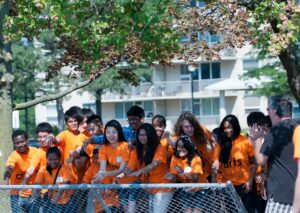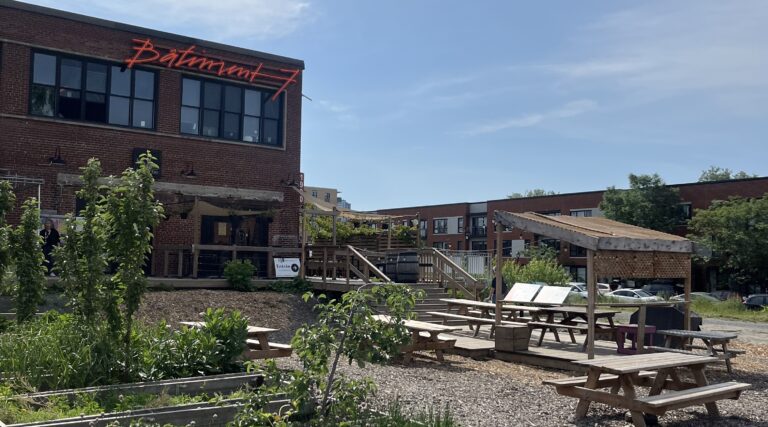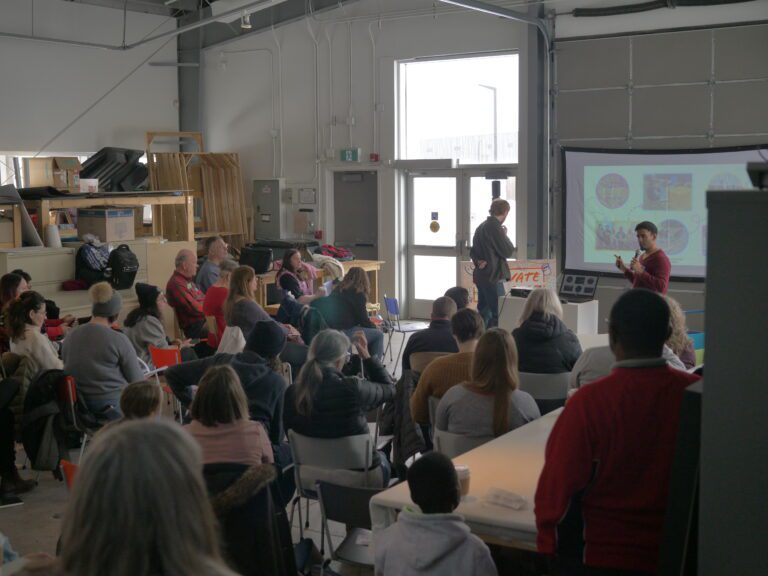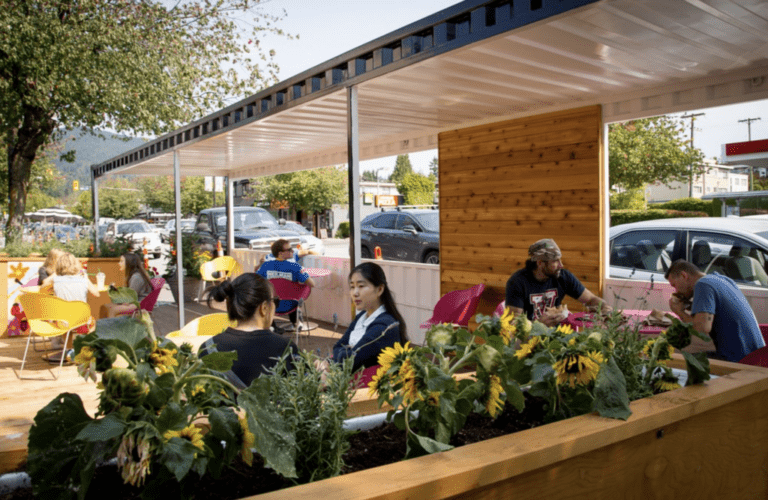Le 4 juin 2024, l'Initiative des communautés en santé a organisé une séance virtuelle de mobilisation intitulée "Rebondir vers l'avant : Cultiver la connexion, l'appartenance et la résilience collective" avec Anne Gloger du Catalysts' Circle. La session a exploré l'approche des communautés connectées, un modèle né du travail de pionnier du East Scarborough Storefront, et a réuni un panel d'initiatives financées par l'ICH pour partager leurs histoires, leurs réflexions et leurs apprentissages sur ce qu'il faut pour cocréer dans des communautés et des contextes variés et diversifiés.
Cet article a été rédigé par Anne Gloger à la suite de la session Mobilizer afin d'explorer plus avant les principes et les pratiques qui peuvent libérer le potentiel des communautés connectées.
Rebondir vers l'avant
Par : Anne Gloger
Avez-vous remarqué que lorsque nous racontons des histoires ou essayons de nous souvenir d'événements, COVID-19 est devenu un point de référence ? C'était avant COVID ? demandons-nous. Que faites-vous maintenant, après COVID ? Nous faisons cela parce que les crises sont des moments déterminants pour nous en tant qu'individus, pour nos communautés et pour notre société dans son ensemble. Si le COVID-19 est un exemple que nous partageons tous, des communautés individuelles à travers le pays et le monde ont vécu dans leur propre contexte des événements déterminants et traumatisants qui les ont changés à jamais.
J'ai décrit l'un de ces événements lors d'une session de mobilisation organisée par l'Initiative pour des communautés en bonne santé. une session de mobilisation organisée par l'Initiative pour des communautés en bonne santé. J'ai raconté l'histoire d'un événement traumatisant survenu en 2012 lors d'une fusillade de masse dans une communauté de l'est de Scarborough, qui a laissé les gens sous le choc : 22 jeunes ont été abattus et deux d'entre eux ont été tués. L'histoire de la fusillade elle-même, du chagrin et du traumatisme qu'elle a causés aux familles et aux amis des victimes, c'est à eux de la raconter, pas à moi. L'histoire que je suis en mesure de partager est celle de la façon dont les organisations communautaires, les institutions, le personnel municipal et les groupes de base se sont réunis pour soutenir cette communauté traumatisée. Il s'agit de la manière dont ces groupes ont réagi au choc immédiat de l'événement, certes, mais surtout de la manière dont ils ont continué à se réunir au fil du temps pour concevoir et mettre en œuvre une approche communautaire globale.
Ils ont mis de côté leurs intérêts organisationnels pour soutenir la communauté, non pas pour revenir à la situation d'avant la crise, mais pour aller de l'avant vers une nouvelle réalité.
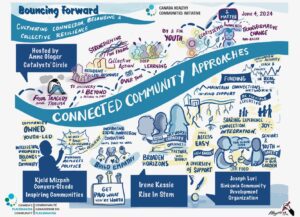
Graphique représentant la session virtuelle de Mobilizer. Par Patricia Kambitsch/ Playthink.
S'unir : une réponse communautaire
Mes collègues et moi-même avions la lourde tâche de réunir, coordonner et aligner les idées, les mandats et les protocoles afin d'obtenir une réponse de l'ensemble de la communauté qui soit significative pour la population locale. Le lendemain de la fusillade, alors que j'entrais dans la salle où étaient réunies 70 personnes passionnées, toutes désireuses d'aider, je me suis sentie un peu mal. Comment allions-nous pouvoir élaborer rapidement et efficacement le plan d'action collectif, coordonné et pertinent dont nous avions besoin ? Il s'est avéré que nous savions déjà comment faire : nous avions mis en place les éléments de base depuis plus d'une décennie ; c'est la manière dont nous avons utilisé ces éléments de base que je vais vous décrire dans ce blog.
La première chose que nous avons faite dans les premiers jours qui ont suivi la crise a été de réunir tous les acteurs clés et de chercher à clarifier notre objectif collectif auprès des personnes les plus proches du terrain. Ce sont les personnes à la base qui ont donné l'orientation à suivre :
- que faire : donner la priorité au soutien des actions menées par les résidents et à l'amélioration de la qualité de vie.
- ce qu'il ne faut pas faire : inonder la communauté d'étrangers bien intentionnés
Le fait que nous ayons la capacité de prendre l'initiative des personnes à la base n'est pas le fruit du hasard : c'est le prolongement d'une méthode de travail que nous avons collectivement perfectionnée au fil des ans. Soutenir le travail de la base et concevoir des stratégies centrées sur les habitants et des plans d'action conjoints semble simple. Cela semble être la façon dont chaque communauté devrait travailler et pourtant, c'était - et c'est toujours - comme nager à contre-courant dans un système qui n'est tout simplement pas conçu pour cela.
À East Scarborough, nous avons eu de la chance. Des dizaines de personnes présentes dans la salle en ce jour horrible avaient eu, plus d'une décennie auparavant, une occasion unique : concevoir collectivement et en collaboration une organisation communautaire à partir de zéro. Ce qu'ils ont conçu, c'est une organisation destinée à soutenir précisément le type d'approche intersectorielle centrée sur la communauté qui était nécessaire ce jour-là. Il s'agit de l'organisation East Scarborough Storefrontet l'approche, baptisée plus tard Connected Community Approach, consistait à tisser intentionnellement des réseaux, à instaurer la confiance et la co-création.
Les jeunes de East Scarborough font tomber les barrières (en enlevant une clôture qui bloquait l'accès au terrain de sport et au jardin) Photo : Vitrine de East Scarborough
The Storefront a convoqué et facilité ce type de processus intersectoriels, centrés sur la communauté, pour co-créer tout ce qui va des marchés et des jardins aux campagnes de plaidoyer et même à la récupération et à la réaffectation d'un ancien commissariat de police qui a été transformé en un centre communautaire prospère. Chacune de ces activités de construction communautaire nous a aidés à créer les éléments de base dont nous avions besoin aujourd'hui. Elles nous ont appris qu'avant toute chose, nous devions réunir les bonnes personnes, celles qui sont à la base et celles qui ont des mandats et des structures officiels, afin de concevoir ensemble une stratégie qui prenne l'initiative de ceux qui sont les plus proches des réalités du terrain.
Tisser le tissu social
Ces éléments constituent ce que nous appelons aujourd'hui le tissu social de la communauté. Il s'agit d'une méthode de travail qui met l'accent sur les liens et les interactions qui nous unissent tous en tant qu'individus et en tant que société : elle est fondée sur notre humanité commune. En tant que professionnels tissant le tissu social, nos priorités en toutes choses - qu'il s'agisse d'un projet de jardinage, d'une campagne de plaidoyer ou d'une réponse à une crise - sont les suivantes :
- Favoriser un sentiment d'appartenance et d'action
- Instaurer la confiance entre les personnes et les organisations/institutions
- Faciliter la compréhension au-delà des différences
- S'aider mutuellement à désapprendre les pratiques racistes/coloniales
- Fournir un accès transparent à une large gamme de services
- Éliminer les obstacles aux opportunités
- Mettre les gens en contact avec des possibilités de s'engager dans des processus civiques
- Créer des opportunités pour préserver l'environnement
- Soutenir les processus qui rendent la recherche, le financement et les politiques pertinents dans le contexte communautaire
Élaboration d'un plan d'action
C'est ainsi que nous avons conçu un plan d'action efficace et significatif comprenant des actions menées par des groupes de base, des travailleurs de première ligne, des directeurs exécutifs, des entreprises locales et des fonctionnaires municipaux, entre autres ; un plan d'action profondément ancré dans les priorités des résidents et l'humanité partagée de toutes les personnes impliquées, dont vous trouverez des exemples dans le tableau ci-dessous.
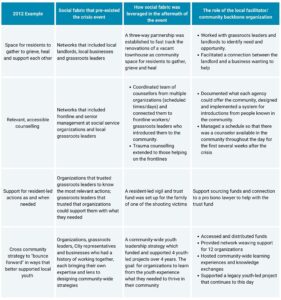
Ce jour-là, ainsi que dans les semaines et les mois qui ont suivi, j'ai été très reconnaissante à tous de leur bonne volonté, de leur expertise et de leur attention. De nombreuses personnes sont revenues à la table jour après jour, puis semaine après semaine, pour explorer les possibilités d'un avenir meilleur. Convoquer et animer ce groupe n'était plus un défi, c'était une source d'inspiration.
Le fait de travailler au Storefront signifiait que je pouvais passer mon temps à écouter des histoires, des idées et des visions du monde et à explorer, en collaboration, les moyens de les réunir en un plan cohérent et significatif. Lorsque je parle aux gens de notre rôle en tant que personnel du Storefront, ils en reconnaissent immédiatement la valeur et sont souvent surpris d'apprendre que ce rôle n'existe pas dans toutes les communautés. Il est clair que nous avons besoin de personnes et d'organisations ancrées dans les communautés qui peuvent faciliter les processus permettant de briser les silos, de construire des ponts, d'explorer les moyens d'inverser la tendance alarmante à la marginalisation géographique et de rassembler les gens pour se préparer à un événement de crise majeur, y répondre, s'en remettre et repartir de l'avant.
Mais ce rôle, s'il existe, est généralement exercé en marge du bureau de quelqu'un, par une personne qui n'est pas rémunérée ou qui est payée pour fournir un programme ou un service spécifique, et non pour faciliter les processus collectifs.
Dans la société canadienne, nous célébrons la connectivité. Dans le sillage du COVID-19 et du bilan racial de 2020, les appels se sont multipliés en faveur d'une approche "rien sur nous sans nous". Et chaque jour, nous comprenons mieux à quel point la confiance entre les personnes et les organisations/institutions est fragile. Le renforcement du tissu social d'une communauté dépend de ce qui se passe sur le terrain, mais il ne peut être déchargé sur le dos de personnes non rémunérées ou mal payées pour qu'elles assument le poids de questions qui peuvent se poser au sein de la communauté, mais qui découlent de systèmes échappant à leur contrôle.
Nous avons besoin que les acteurs du système et les acteurs de la communauté travaillent ensemble.
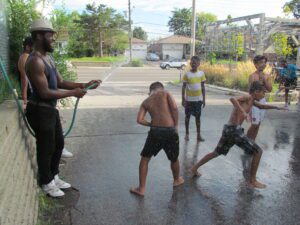
Des jeunes utilisent l'espace public pour aborder les problèmes de chaleur dans la communauté. Photo : Vitrine de Scarborough Est
Pourtant, à quelques exceptions notables près, il y a très peu de fonds disponibles pour ce type de travail et peu d'attention est accordée à la formation des personnes qui s'en chargent.
L'une de ces exceptions notables a aidé la communauté d'East Scarborough à rebondir après la tragédie de 2012. Au fur et à mesure que les gens se réunissaient autour de la table, semaine après semaine, nous avons commencé à voir ce qui était nécessaire : une approche qui nous aidait tous à apprendre des jeunes eux-mêmes ce dont ils avaient besoin et ce qu'ils attendaient des organisations et des institutions conçues pour les soutenir. Et un bailleur de fonds l'a compris.
Le Youth Opportunity Fund a reconnu la valeur d'une approche communautaire globale pour créer une nouvelle et meilleure normalité après une crise majeure. Il a financé une stratégie de rebond vers l'avant qui mettait les jeunes au premier plan.
Au cours des quatre années suivantes, nous avons pu financer et soutenir quatre groupes dirigés par des jeunes afin qu'ils conçoivent et mettent en œuvre leurs propres projets et que le reste d'entre nous se concentre sur l'apprentissage à partir de leur expérience. 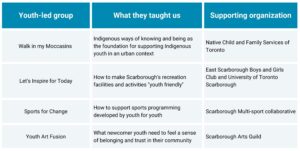
Chacun avait un rôle à jouer : le nôtre, à The Storefront, était de faciliter les processus (logistiques et stratégiques) afin que l'apprentissage soit intégré dans toute la communauté et lié à des stratégies à l'échelle de la ville comme Toronto Strong Neighbourhood Strategy (Ville de Toronto) et Action for Neighbourhood Change (Centraide). Et pendant ces quatre années, nous avons été financés pour faire exactement cela. Cependant, pendant la majeure partie de mon temps au Storefront, et jusqu'à aujourd'hui, le personnel du Storefront a dû rassembler des fonds de manière créative afin d'être l'organisation que nous avions été conçus pour être.
La vitrine a été créée par la la communauté pour la communauté d'East Scarborough, car c'est ce dont elle avait et a toujours besoin : un facilitateur de processus collectifs. Au fil des ans, The Storefront a pu prendre du recul et réfléchir à ce qui était différent dans son approche, qui avait fourni les éléments de base pour une réponse communautaire globale aux crises.
Cette réflexion a conduit à la codification de l'approche dans un cadre désormais connu sous le nom de Connected Community Approach (approche de la communauté connectée).
L'approche des communautés connectées
Ce cadre est pratique et adaptable et peut être activé au niveau local ou par des institutions cherchant à utiliser leur mandat pour contribuer aux communautés locales. Il propose une méthodologie "comment faire" qui s'articule autour de 10 clés pour libérer le potentiel de chaque communauté à se préparer à une crise, à y répondre, à s'en remettre et à rebondir après celle-ci.
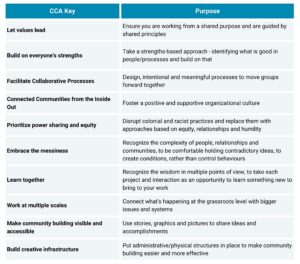
Je raconte l'histoire de la fusillade de 2012 pour trois raisons. Tout d'abord, parce que le soutien apporté à la réaction, au rétablissement et au "rebondissement" qui s'en est suivi m'a changé à jamais. Ce fut un moment décisif qui a galvanisé ma foi en l'homme et en la communauté. C'est en grande partie à cause des événements de 2012 que j'ai choisi de me consacrer à aider les personnes, les organisations et les institutions à découvrir leurs propres capacités à contribuer à la santé, à l'équité et à la résilience de leurs communautés.
Deuxièmement, je raconte cette histoire parce qu'elle est un exemple convaincant de ce qui peut se produire lorsque nous investissons intentionnellement dans les capacités des communautés et que nous les renforçons, afin d'entretenir les conditions sous-jacentes qui permettent aux personnes, aux organisations et aux institutions de s'attaquer collectivement et efficacement aux problèmes et aux défis qui se posent.
Enfin, j'espère que cette histoire contribuera à inspirer de nouvelles façons de se préparer aux événements de crise, qui vont au-delà de la gestion des urgences pour se concentrer sur les interactions et les liens qui nous unissent en tant qu'individus et en tant que société.
______________________________________________________________________
Pour en savoir plus sur l'approche des communautés connectées, regardez la présentation complète de la session de mobilisation ici et suivez le cercle des catalyseurs sur leur site web.

